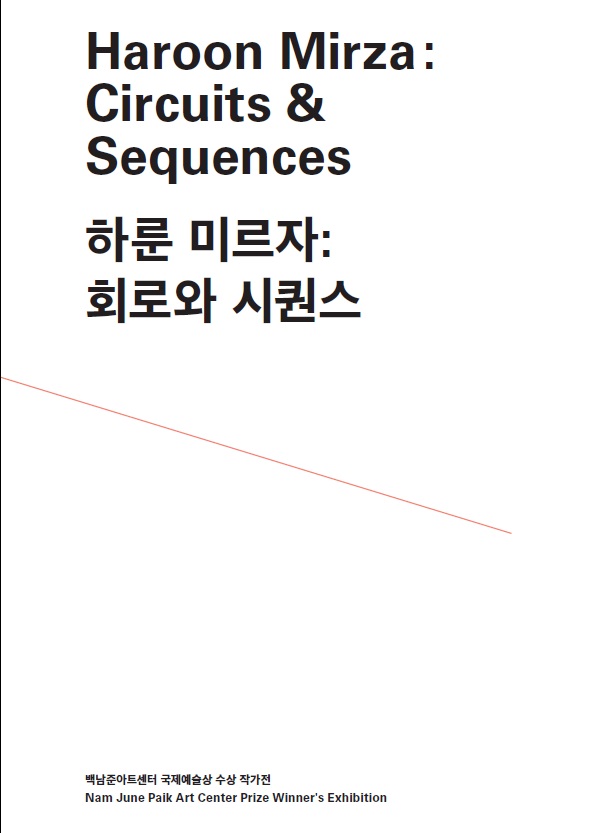Nam June Paik Art Center Prize Winner’s Exhibition Haroon Mirza: Circuits & Sequences
admin - May 2, 2016
Hits 2856

Making Sense of White Noise, Haroon Mirza
Mike Stubbs (Director of FACT, Liverpool and Jury Member)
Haroon Mirza was chosen by the jury for his ability to consistently extend his practice, with his fascination into media, time and transmission much like Nam June Paik.
It is this continuing belief in art as a fictive realm, rather than as existing in service to ‘progress’, that has enabled art to push our boundaries, conceptually, politically and intellectually. The license, with which we give artists, both expresses societies reflexive maturity, and allows increasingly ephemeral objects to gain value in our minds and markets.
Incorporating found familiar household electrical devices such as record decks, transistor radios, desk lamps and loudspeakers, Mirza’s works, resonates the voice of Dadaism, exploring electro-magnetic forces at a human scale. Artworks and performances that maintain an openness to universal conditions, material circumstances and perception, which directly sharpen our senses through a synesthetic art experience, there by invoking ontology.
Earlier work, especially those incorporating found vintage objects, seem imbued with a ‘sentimental’ memory through their patina and our own cultural references of them. Nam June Paik might have enjoyed these re-combinations of domestic devices as a proto — hacker himself, fascinated with changing objects and their outputs to form new functions and relationships. Nam June Paik experimented with video synthesizers, performance and television, bringing together new sets of knowledge and technologies. His artwork not only referenced the new televisual era through the sculptural and kinetic values of the television set, but also exploited the potential of the globalized network itself, and the noise(ghost) in the machine.
After the Second World War, the remnants of an industrial economy and a modernist belief in technology as a solution, combined with imagination and a surplus of the war machinery, provided the correct conditions for experimentation. Science and technology entered hobbyism: wireless, the ham radio, model aircraft, learned from a culture of wartime invention. Nam June Paik’s own father, a textile mill owner would have understood invention through trade and a reactive virtuous circle through his own son’s practice. The converting of devices for artistic purposes is a reminder of war-time habits, and acts as pre-cursor to our current hacker culture and anecdotal innovation.
The physicality of Mirza’s work, sculptural and sonic, is playful and critically expressing a need to make the invisible, visible, and a need for material engagement with the tangible. Yet, rather than making things seamless, Mirza prefers to deconstruct with a humour and a desire to physically manifest the intangible in space.
If a work of Art can be thought of as a fiction; it is as an obscurified and predictive form that balances upon the cusp of reality. The artist, by their own criteria, examines an existing subject and passes judgement upon how this should be re-formed; on how things ought to be. This outcome is imagined and fictitious, but attains a perceived significance and potential for prescience through the reverence with which we have come to behold a work of Art. The role that the artist fulfils, of observing the world and interrogating its makeup, presents an opportunity to demonstrate the possibility of change; at the edge, where the infinite potentiality of the fictional bleeds into actuality.
We, the audience, are left with our own thoughts and experience, building meaning through memory, sensation and embodied knowledge. Haroon Mirza reverses the utility and simple narratives, simultaneously invoking phenomena which we the audience can find as complex as we need. Work, which demands the audience’s imagination for completion; which shares a process of experimentation in creating and remixing Mirza’s own audio-visual system, one of chance and unpredictability. Music is everywhere; if we listen sensitively enough we can here it now in our immediate noise field, be that white noise or a waterfall.
Table of Contents
- Questions to Nam June Paik Art Center Prize Winner 8
- Acknowledgement Jinsuk Suh(Director, Nam June Paik Art Center) 14
- Circuits & Sequences Sooyoung Lee(Curator, Nam June Paik Art Center) 24
- Works 34
- 29 January 2015 Nam June Paik Art Center Prize Winner’s Special Talk Haroon Mirza 80
- General Comments by the 2014 Nam June Paik Art Center Prize Jury Mike Stubbs(Director of FACT, Jury Member) 92
- Exploring Haroon Mirza in Detours Seongeun Kim(Curator, Samsung Museum of Art Leeum) 102
- Exhibition Opening 110
- Light & Sound Studio 111
- Biography 112
(ISBN 978-89-97128-21-1, 113pages, KRW 20,000)
Comments [0]
Leave a comment
You must be logged in to post a comment.
















